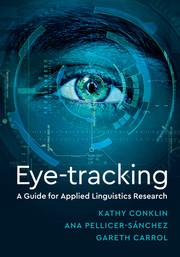Book contents
- Frontmatter
- Contents
- Figures
- Tables
- Preface
- Chapter 1 Introduction to Eye-Tracking
- Chapter 2 Choosing the Equipment
- Chapter 3 Practicalities of Eye-Tracking
- Chapter 4 Researching Reading
- Chapter 5 Researching Listening and Multimodal Input
- Chapter 6 Using Eye-Tracking in Other Contexts
- Chapter 7 Working with the Data
- Chapter 8 Conclusions
- References
- Index
8 - Conclusions
Published online by Cambridge University Press: 14 September 2019
- Frontmatter
- Contents
- Figures
- Tables
- Preface
- Chapter 1 Introduction to Eye-Tracking
- Chapter 2 Choosing the Equipment
- Chapter 3 Practicalities of Eye-Tracking
- Chapter 4 Researching Reading
- Chapter 5 Researching Listening and Multimodal Input
- Chapter 6 Using Eye-Tracking in Other Contexts
- Chapter 7 Working with the Data
- Chapter 8 Conclusions
- References
- Index
Summary
In this book we have tried to present a beginners’ guide to eye-tracking for anyone working in the field of applied linguistics. Given the increasing availability (and affordability) of this technology, it is becoming a popular choice for a wide range of topics that will be of interest to applied linguists. We have tried to condense thirty-plus years of eye-tracking literature to provide an overview of what eye-tracking has told us and what it can tell us, and tried to outline the principles that underpin this methodology. We have presented a practical guide to choosing the right equipment for your needs, provided a walkthrough of the process of designing and building a study using the main systems available, and offered some guidance on working with data. Throughout the seven chapters in this book we have outlined the main methodological issues that need to be considered when conducting eye-tracking research in a wide range of areas. As with any approach to research, the best way to learn is to dive in. Many of the methodological issues raised in the book will become much clearer once you start designing and building your own study, working with participants, and collecting and analysing data.
As we have shown in this book, eye-tracking is certainly a useful and important methodology, and a valuable tool for researchers from a variety of backgrounds with a range of interests. It provides a way to investigate online linguistic processing and behaviour in a relatively naturalistic way, and a whole host of important research topics have been enriched by well-designed, thoughtful eye-tracking studies. But it is not a panacea, and a number of misconceptions exist that may limit both the application of the methodology and the interpretation of eye-tracking data. A version of the following list of misconceptions was first proposed by Bojko and Adamczyk (2010) for eye-tracking in the field of user experience research, and restated by Grucza (2013) as it relates to translation processes. We have adapted the list to be more relevant to the field of applied linguistics, and address some common misconceptions below as a way of wrapping up the issues we have discussed throughout the book.
- Type
- Chapter
- Information
- Eye-TrackingA Guide for Applied Linguistics Research, pp. 206 - 209Publisher: Cambridge University PressPrint publication year: 2018



